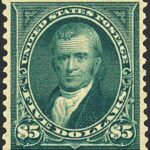“The people made the Constitution, and the people can unmake it. It is the creature of their own will, and lives only by their will.”
In between the Canadian Embassy and the U.S. Bankruptcy Court, just south of C St. NW, is John Marshall Park. At the northern edge of the tree-lined park, framed by the District of Columbia Court of Appeals, sits the statue of the man who defined the powers of the Constitution, the judiciary, and the relationship between the federal government and the states: John Marshall.

The statue is a recast of one that formerly sat in front of the Capitol Building, but today sits in the Supreme Court. The sculptor was William Wetmore Story, the son of Joseph Story who served on the Supreme Court with John Marshall. Another of Story’s statues, that of Joseph Henry (the first Secretary of the Smithsonian Institution), stands in front of the Smithsonian Institution Building on the National Mall.
The original statue of Marshall at the west front of the Capitol building was moved before President Reagan’s inauguration in 1981, the first to be held on the West Terrace. The statue that sits in John Marshall Park today was dedicated on October 30, 1985, two years after the opening of the park, in a ceremony attended by Chief Justice Warren Burger and Marshall’s great-great grandson Marine Corps Brigadier General St. Julien Marshall.

John Marshall’s public service was more than as Chief Justice. As a soldier in the Continental Army he served from 1775 to 1780 and wintered with Washington at Valley Forge. As a delegate to the Virginia Convention of 1788 – along with future president, James Madison – he voted for his state to ratify the Constitution. In 1799 he was successfully elected to the House of Representatives but was quickly appointed to Secretary of State in 1800 under President John Adams. This appointment would also be short-lived and he was appointed Chief Justice in 1801.
As Chief Justice, Marshall is remembered for strengthening the power of the judicial branch and the federal government. In Marbury v. Madison * he cemented the court’s authority of judicial review – the concept that the Supreme Court is the final arbiter of the Constitution. Although the details are many, the essence was that the Judiciary Act of 1789 expanded the powers of the court in an unconstitutional way, and thus the law was invalid. Marshall essentially expanded the powers of the court while at the same time limiting them.

In McCulloch v. Maryland he ruled that the state of Maryland did not have the right to tax the Second Bank of the United States, and essentially that states could not tax the federal government. In Gibbons v. Ogden he overturned a state-granted monopoly on a steamship route between New York and New Jersey because the Constitution granted the power to regulate interstate commerce exclusively to the federal government. In Cohens v. Virginia he established the Supreme Court’s primacy over the state courts by hearing an appeal to a ruling of the Virginia Supreme Court.
His decisions were not without controversy, however. In Johnson v. M’Intosh he invalidated a private land sale in favor of a federal land grant. In essence he ruled that private citizens could not purchase lands from Native Americans but that the federal government could give that same land away. In contrast, in Fletcher v. Peck and Dartmouth College v. Woodward he ruled in favor of private contracts over the laws of the government.
In Cherokee Nation v. Georgia, in which the Cherokee sought to prevent the state of Georgia from extending its laws over their territory, Marshall ruled that the Cherokee weren’t a sovereign nation and did not have standing to sue the federal government. Marshall said, “The majority is of the opinion that an Indian tribe or nation within the United States is not a foreign state in the sense of the constitution,” and that “the relationship of the tribes to the United States resembles that of a ‘ward to its guardian’.” Fellow judge Justice William Johnson went further and said that Native Americans were “nothing more than wandering hordes, held together only by ties of blood and habit, and having neither rules nor government beyond what is required in a savage state.” Although this opinion is rightly considered barbaric today, it was in keeping with the times. Seven years after this decision the Cherokee were forcibly removed from their lands where thousands died along the Trail of Tears.
Marshall is one of the few people to have worked in all three branches of government: in the legislative branch as a representative from Virginia, in the executive branch as Secretary of State under John Adams, and in the judicial branch as Chief Justice of the Supreme Court. He introduced the practice of the court issuing only one opinion, whereas before, every justice would author his own. [He also got rid of the British tradition of wearing powdered wigs and red robes.] He is the longest serving Chief Justice, having served for 34 years (of the other 16, only two have served more than 20 years). He has appeared on paper money and stamps, and numerous law schools bear his name. His cases are still cited in courtrooms today.

* In 1800, Democratic-Republican Thomas Jefferson was elected president and the Democratic-Republican Party took control of both houses of congress. But before he could take office, John Adams and a sympathetic congress passed the Judiciary Act of 1801 – which modified the Judiciary Act of 1789 – to stack the courts with 58 new judges sympathetic to Adams and the Federalist Party. And before the new appointments could take effect, the commissions had to be delivered. As Secretary of State at the time, John Marshall facilitated the delivery of most of them but could not deliver all of them before the Jefferson administration took office. The new Secretary of State, James Madison, would not deliver the rest of the commissions.
William Marbury was one of those who did not receive his commission, so he sued Madison to force him to deliver his commission under a provision of the 1789 act that allowed the court to hear a case forcing the federal government’s hand. The court ruled Marbury had the legal right to his commission but that the court did not have the jurisdiction to hear the case because the Judiciary Act of 1789 – which expanded the Supreme Court’s jurisdiction and gave Marbury standing to sue the government to force Madison to deliver the commission – conflicted with Article III of the Constitution, and thus, the entire act was invalid. Although technically a victory for Madison and the Democratic-Republicans, Thomas Jefferson would lament the decision, believing that it put too much power to define the Constitution in the hands of the Supreme Court.
Resources used for this article:
https://en.wikipedia.org/wiki/John_Marshall
https://en.wikipedia.org/wiki/Chief_Justice_John_Marshall
https://en.wikipedia.org/wiki/William_Wetmore_Story
By Jack Eisen Washington Post,Staff Writer. (1985, Oct 31). A justice for all. The Washington Post (1974-Current File) Retrieved from https://search-proquest-com.dclibrary.idm.oclc.org/docview/138514283?accountid=46320


